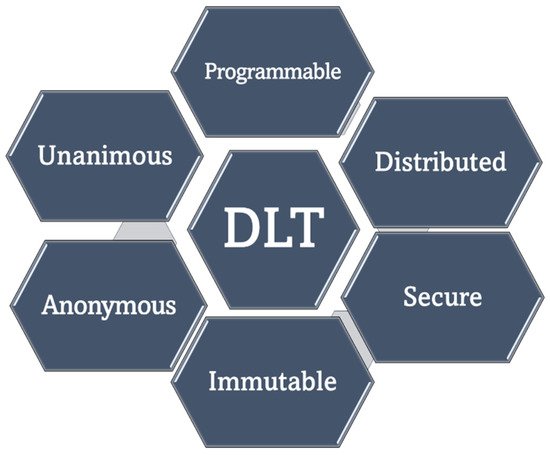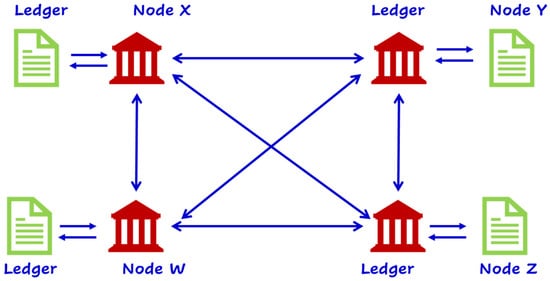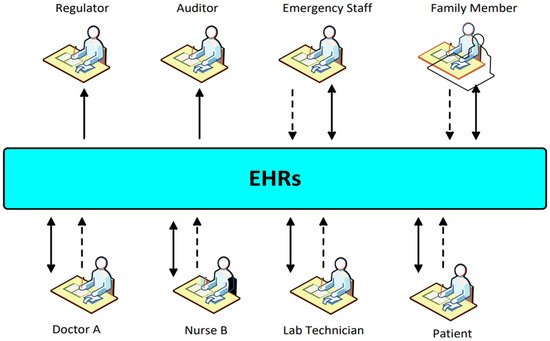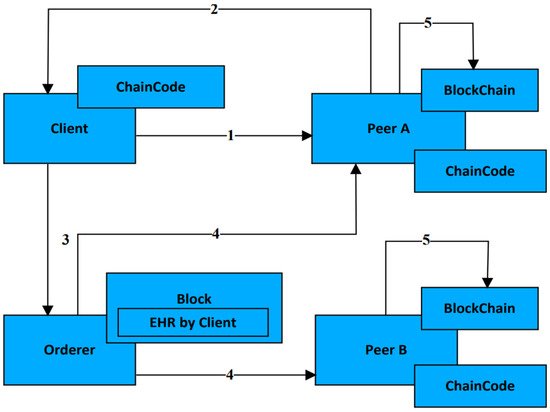The emergence of blockchain technology makes it possible to address disparate distributed system security concerns in formerly ridiculous practices. A key factor of this ability is the decentralization of the symmetrically distributed ledgers of blockchain. Such decentralization has replaced several security functionalities of centralized authority with the use of cryptographic systems. That is, public or asymmetric cryptography is the key part of what makes blockchain technology possible. Recently, the blockchain experience introduces the chance for the healthcare field to implement these knowhows in their electronic records. This adoption supports retaining and sharing the symmetrical patient records with the appropriate alliance of hospitals and healthcare providers in a secure decentralized system, using asymmetric cryptography like hashing, digitally signed transactions, and public key infrastructure. These include specialized applications for drug tracking, applications for observing patients, or Electronic Health Records (EHR). Therefore, it is essential to notice that the principled awareness of the healthcare professionals is the leading point of the right perception ethics.
1. Introduction
Blockchain applications are used by a variety of industries, including finance, healthcare, manufacturing, and education, to benefit from the distinctive set of properties that this technology possesses. Blockchain technology (BT) provides advantages in credibility, trustworthiness, organization, and transparency [
1]. With its special blend of properties, including decentralization, immutability, and transparency, blockchain technology (BT) has a great deal of promise to support a variety of industries [
2]. We anticipate that this technology will have positive applications in academia and science.
One sector where blockchain is anticipated to have a big influence is healthcare. Researchers and practitioners in health informatics constantly struggle to keep up with the advancement of this field’s young but quickly expanding body of research. This article presents a comprehensive assessment of recent studies investigating the use of blockchain technology in the healthcare industry [
3].
Healthcare is an important sector for both the developed and upcoming nations [
4]. The overall capabilities of the medical and healthcare sector have been improved further by initiating innovative and latest computer technologies within the sector. Such advancements in computer technologies may help physicians and other relevant health providers with the timely diagnosis and management of numerous health-related problems [
5]. Different revolutionary and emerging computer technologies have since been applied within other sectors with highly promising outcomes. Such technologies comprise the Internet of Things, Blockchain, Data Mining, Cloud Computing, and the Internet of Things, Blockchain, Data Mining, Cloud Computing, and Internet of Things, Blockchain Data Mining, Cloud Computing, and many others [
6].
As Ratta et al. (2021) [
7] described, Blockchain is a point-to-point distributed network within which no single third party has been involved in the communication and transaction. Blockchain operates mainly by maintaining a symmetrical copy of the decentralized ledger for all users under the security of asymmetric cryptography. All the undertakings are isolated and not linked to other relevant transactions. For instance, the popular innovatory idea of cryptocurrency is supported by blockchain technology [
8]. Similarly, cryptocurrency is highly believed to be very secure and unable to be hacked; the same blockchain concept can be applied in other sectors to enhance security and privacy issues. The healthcare sector is one of the relevant industries where the technology can effectively be applied.
Within the Blockchain, a ledger system that is publicly distributed is accessible to any individual in a symmetrical manner. In this case, the blockchain ledger is the list of records that keep the required information sequentially [
9]. The block is the container with all the individual transaction details in this case. The block has both the header and the details of the transaction. The header is responsible for keeping all the information related to the block [
10]. With its associated security features, Blockchain can easily be into the healthcare system to enhance the effectiveness of the sector’s operations. The present paper seeks to establish how Blockchain can be applied in the healthcare sector, highlighting the specific challenges and concerns.
1.1. Blockchain Principles
A Blockchain is a public, decentralized, and distributed database managed by multiple participants, across multiple nodes connected through a peer-to-peer (P2P) network. Blockchain acts as a distributed ledger technology (DLT) where users can digitally verify the issued transactions without the need for trusted third-party (TTP) authority [
11]. Typically, Blockchain presents a secure and autonomous consentaneous approach to expanding the DLT over time while keeping the data immutable and irrefutable [
12]. The main characteristics of Blockchain-DLT are demonstrated in
Figure 1.
Figure 1. Main properties of distributed ledger technology (DLT) [
12].
Blockchain is a sort of DLT that records the transactions using an immutable cryptographic signature called a hash using an algorithm (e.g., SHA 256) [
13]. That is, changing one block in the chain is going to be directly noticeable as tampered with. Therefore, for the blockchain system to be corrupted by the hacker, almost, all blocks across the distributed chain need to be changed.
Figure 2 illustrates the principle blockchain anatomy. Every node will have a complete copy of the ledger (blocks) and the block is composed of several data (transactions’ list, …etc.). Blocks are connected by connecting every block with its predecessor and subsequent through a hash value. The blocks are linked together chronologically and cannot be modified after they are recorded without writing the entire ledger history again [
14]. Nodes use a defined algorithm to reach a consensus on what ledger version is true and accurate [
15].
Figure 2. The Principles of a Blockchain Anatomy [
15].
Blockchain has a wide range of applications, it provides solutions addressing several security concerns such as industrial applications, financial applications, medical/healthcare applications, smart grid and others [
16]. For instance, in healthcare, a blockchain network is useful to preserve and exchange patient data. Blockchain applications can accurately identify serious and even hazardous errors in the healthcare and medical fields. Blockchain is crucial in processing duplicity in clinical trials for better healthcare outcomes [
9].
1.2. Symmetric Decentralized Ledgers of Blockchain
Decentralized ledgers or DL are a set of databases distributed throughout a network and spanning over various topographical sites [
17]. A ledger comprises a compilation of transactional accounts that are globally controlled by multiple parties in distinct sites and organizations [
18]. The participants can assess distributed ledgers at each network node and obtain a symmetrical (identical) version of the distributed data. Once any changes happened in the ledger (such as editing, adding, deleting, …), then the new changes are repeated and reproduced to all participants in order to maintain the symmetry and accuracy of all records across the decentralized database in a synchronized manner [
19].
Figure 3 illustrates an example of decentralized Ledgers of Blockchain maintaining symmetrical copies of the ledger [
20].
Figure 3. An example of decentralized Ledgers of Blockchain [
20].
1.3. Asymmetric Cryptography in the Blockchain
Asymmetric cryptography is effective due to the use of two distinct keys: a public key used mainly for encryption or verifying key and a private key used mainly for decryption or signing key [
21]. Asymmetric keys cryptography is perfectly matched for use in blockchain technology to authenticate identities for transactions and personnel.
A major characteristic of blockchain security relies on its pseudonymous where users need not disclose their real identities to establish a new blockchain account, rather, they are identified by means of addresses that depend on asymmetric cryptography [
22]. Such asymmetric addresses for digital signatures where the user must sign the transaction digitally with his private key when making a transaction with a blockchain account can be later verified by the corresponding verification key (public key) to verify that the account owner authorizes the transaction. This makes it possible to authenticate transactions without revealing the identity of an account’s owner [
23].
Also, transactions run the Blockchain since they transmit value/code between different accounts to be performed on a smart contract policy. Each transaction on the Blockchain is digitally signed using an asymmetric digital signature crypto-algorithm. This, in turn, provides transaction authentication and anti-spoofing.
Figure 4 illustrates an example of using asymmetric cryptography in the Blockchain to maintain integrity and confidentiality [
24].
Figure 4. An example of using asymmetric cryptography in Blockchain [
24].
2. Related Works
Bigini G. et al. (2020) [
25] examined the Blockchain’s role in Internet of Things (IoT) applications. They summarized surveys and research papers that sought to understand current market conditions and identify obstacles to a user-centric approach to the industry’s development. A number of papers have been examined to see how they use Blockchain to move toward a system that is more user centric.
The primary goal of Ratta P et al. (2021) [
7] was to use cutting-edge computer technologies like the Internet of Things (IoT) and Blockchain to improve the efficiency of healthcare systems. Ratta P et al. (2021) indicated that IoT and Blockchain technologies can be used in a variety of healthcare applications. It is worth mentioning that Ratta P et al. (2021) indicated that these two technologies have enormous potential in the healthcare industry once they are integrated.
Rahmani MK et al. (2022) [
26] highlighted the obstacles of trust issues in a cloud environment and potential use cases of blockchain adoption. The study’s findings on the difficulties of cloud computing include the following: centralization, enormous overhead, trust evidence, reduced adaptability, and inaccuracy.
Sharma et al. (2021) [
27] offered a detailed literature analysis that addresses the different prospects of applying blockchain technology in healthcare. The review explores the effort done to facilitate the merger of IoT and Blockchain in the medical sector. Sharma et al. (2021) [
27] stressed that the Internet of Medical Things paradigm also encourages further research into advanced alternatives to suggest blockchain as a service that provides access to essential consistent blockchain infrastructures for different users or devices. The healthcare applications of blockchain technology are constantly being improved, but there are significant challenges to overcome and important decisions to be made in the future. There is still a need for more testing, experiments, and research before the widespread use of blockchain technology in the healthcare industry can be considered safe. We summarize the related works in
Table 1 below.
This entry is adapted from the peer-reviewed paper 10.3390/sym14091760






